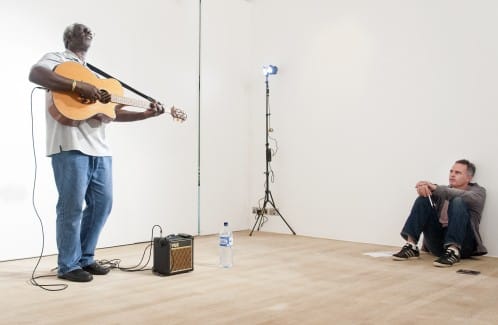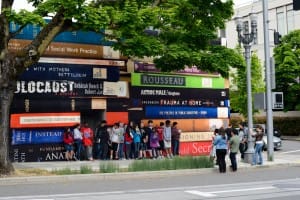Genine Lentine, who has written for Lion’s Roar and Buddhadharma, speaks with artist Harrell Fletcher, whose art embodies not just the Zen concept of beginner’s mind, but also a sense of social responsibility.

Fletcher with busker Stanley Prospere, Tate Modern Performance Room, London.
“People often ask how I’m able to entice random strangers into working with me on art projects about their own lives. The answer is that I appear to actually be interested in the person and his or her activities. And what is the best strategy for appearing interested? The answer is to sincerely be interested, in fact nothing else will work.”
—Harrell Fletcher
Fletcher is the founder and co-director of the MFA program in Art and Social Practice at Portland State University. A self-described “on and off meditator,” his work is informed by his contemplative practice and his abiding “fondness for the human race.”
His socially engaged projects, which have been shown widely throughout the United States and internationally at such museums as The Whitney Museum of Art, MoMA, The De Young and The Royal College of Art in London, freshen up notions of the artist as singular genius at work alone in a studio producing a precious object, and invite us into an expansive and fine-tuned inquiry into interconnection and the effect of the smallest gesture.
 You chose a line from a poem by the Japanese Buddhist poet Issa for the title of an exhibition you recently curated on the intersection of art and agriculture. What’s the connection?
You chose a line from a poem by the Japanese Buddhist poet Issa for the title of an exhibition you recently curated on the intersection of art and agriculture. What’s the connection?
Harrell Fletcher: I’ve been a big fan of Issa ever since I ran across the Robert Hass translations about fifteen years ago. Issa’s poems are almost like little jokes, and for me they make apparent simple and yet profound contradictions and conflicts about being alive. In the case of the exhibition I recently curated about art and farming, the title, from Issa, was: Only Birds Sing The Music Of Heaven In This World. For me, it points to how the attempt to make art will always be trumped by nature. Rather than try to make work that is separate from the natural world, it makes more sense to collaborate with the natural world, which is in some ways what farming is all about.
Yes, I wrote an essay to go along with that show in which I tried to convey that you could use farming as an analogy for art. In the case of industrial farming, there are very few crops grown. They are produced on a large scale, designed for shipping and generic consumption, while local farming projects like CSA’s and farmer’s markets allow growers to cultivate seasonally and to grow a wide variety of different crops which are harvested when they are ripe and only transported a short distance. That system also allows consumers to have direct relationships to growers and farms, which might also affect what the farmer grows.
When it comes to the art world, most artists in my view are operating like industrial farmers, in that they make lots of the same kind of generic objects designed to be shipped and shown to generalized audiences. But there is an alternative to that in what some of us are calling “Art and Social Practice,” which emphasizes localism, site-specificity, collaboration, participation, and a valuing of process and interaction over commercialized objects.

“THE KNOWLEDGE,” an award-winning mural created by Fletcher with assistance from Avalon Kalin, in Portland, Oregon. A poll of faculty, staff, and students at Portland State University determined which books were used.
In general “social practice” starts with context and audience and then work is developed from there, hopefully in significant ways, as opposed to making objects in a studio and hoping that they will be of interest in generic contexts and with generalized audiences. There is something very exciting and interesting about artists working in and with society as opposed to being sequestered off in studios and gallery spaces. By interacting with specific people, histories, and contexts, art works can be produced that are really relevant to local audiences, as well as breaking artists out of the patterns that they form when they are attempting to work in more egocentric and general ways for a commercial art system.
In Zen Mind, Beginner’s Mind, Suzuki Roshi speaks about “soshin,” or “beginner’s mind,” the fresh, supple quality of mind that is open and free of preconception. This quality is abundant in your work. Could you discuss the importance for you in creating situations that help people see aspects of their lives in a fresh way?
For each place and project I really try to have as little as possible determined in advance. That way I’m open to stumbling on people and situations that I might not have otherwise if I had planned everything for a project in advance. I just got back from China where I’m developing a project for the Shanghai Biennial. I had about a week there to figure out what I wanted to do. I was taken to the museum which is under construction where the exhibition will be taking place. I just happened to go during lunch break and lots of the construction workers were taking naps in the middle of the construction site. I was really struck by the beauty of the very human need to rest even in the midst of an industrial looking mess. I took some photos of the sleeping workers, which will be shown as part of the Biennial along with a list of all of the workers’ names and a video of some of the workers talking about the building and their relationships to art. I also am having the Biennial folks give special invitations for the opening reception to all of the workers as a way of showing appreciation for their contribution to the making of the museum. There was no way for me to know about the napping workers in advance of going to Shanghai and running across them. By being open to finding a way to create a project related to that experience, I was able to come up with something that is specific to that context and new and unexpected for me.
I was asked by the Tate to create a performance that would happen in a small gallery at the museum but that would only be experienced through the web. I went to London and spent a couple of days hanging out in the Tube tracking down and listening to buskers (street musicians). Eventually I ran across one person who I really liked. His name is Stanley Prospere and he is originally from St. Lucia in the Caribbean. He plays in the Tube as his main source of income and performs a mix of originals and covers, some country, some gospel, and some Creole. I really liked his music and got a good feeling from him when I talked to him. So for the performance I had Stanley perform four songs at the Tate and in-between and afterwards I asked him questions about his life and what it was like to be a busker. The Tate paid him too, so that was nice. The project was like many of my past ones in that I was given an opportunity that I then shared with someone else who wouldn’t normally be invited to participate in a museum exhibit.
All photos courtesy of Harrell Fletcher. To see more of his work, visit www.harrellfletcher.com.
